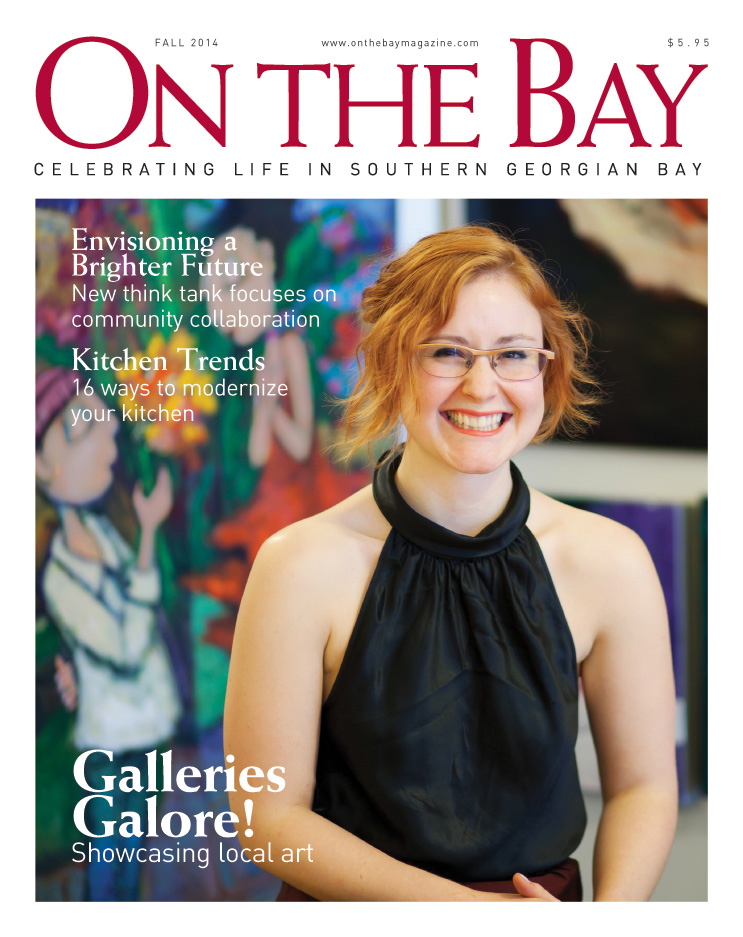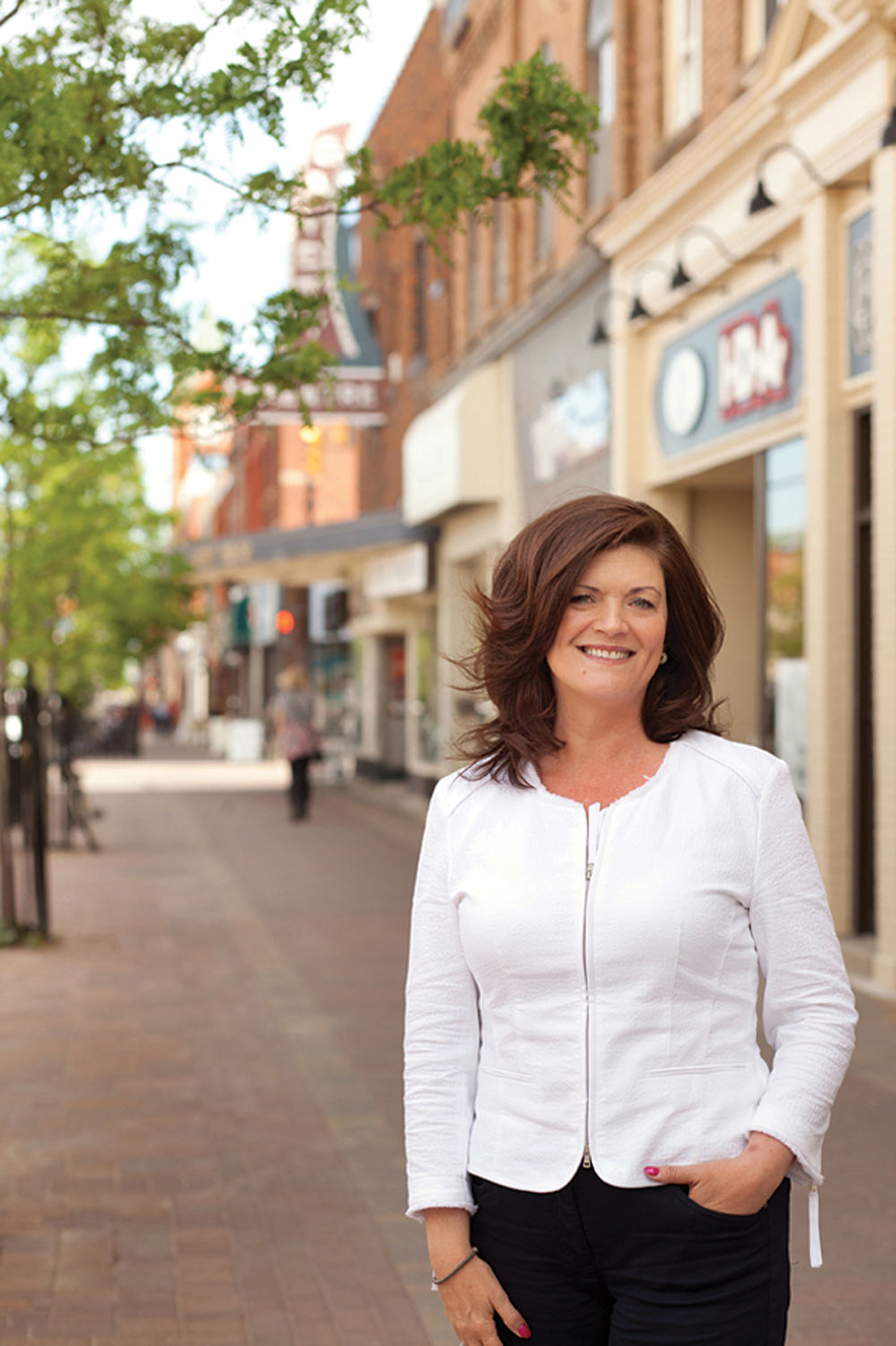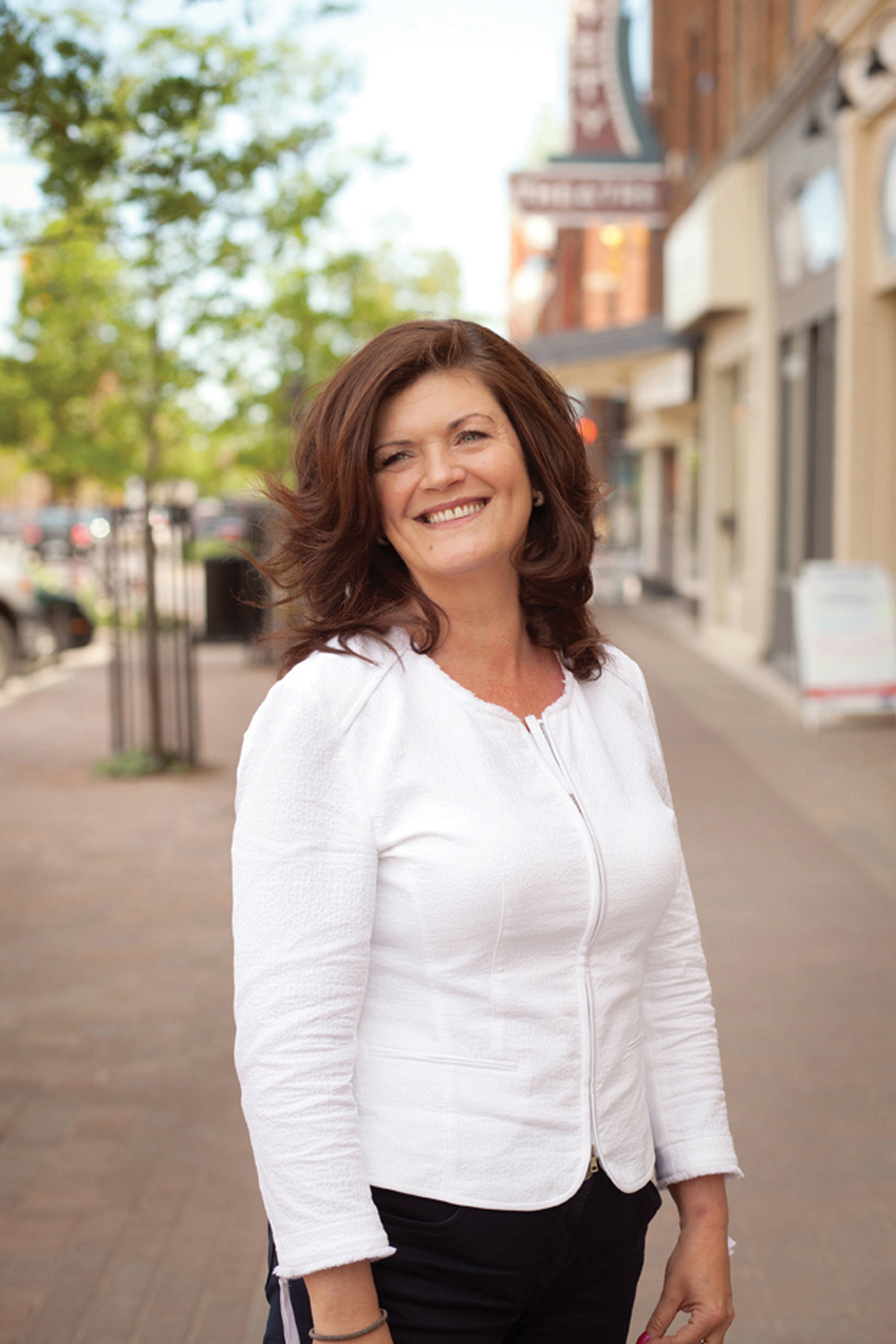Can community engagement and collaboration create a more prosperous and sustainable future for Southern Georgian Bay?
story by Janet Lees
Imagine a Southern Georgian Bay where everyone works together, regardless of geographic boundaries or political, personal or economic interests, to make the entire region more prosperous and sustainable; where a strong “sense of place” draws new entrepreneurs, businesses, professionals, residents and tourists to the area to enjoy the rich culture, abundant experiences and active lifestyle our region has in spades.
That’s the vision of a new not-for-profit ‘think tank’ organization, the Institute of Southern Georgian Bay*. With the goal of achieving “prosperity through collaboration,” the Institute has already attracted a diverse group of movers and shakers from the local business, tourism, arts and culture, healthcare, education, economic development, agriculture and food sectors.
The Institute is the brainchild of Don May – a professional land use planner who has been involved in collaborative projects in other communities such as Hamilton and Burlington – and David Green, a marketing professional who has worked with Skills Canada and the WorldSkills organization. Since floating the think tank idea, May and Green have been meeting with various individuals and groups to identify the issues and pinpoint specific projects the Institute could get behind or implement.
“People like [business guru] Roger Martin, [socio-economic journalist] Diane Francis and [urban theorist] Richard Florida are all saying that our institutions and the historical way we do business are not preparing us for the future,” says May in explaining the rationale behind the Institute. “This isn’t unique to this area. How we do things may not be the right way to prepare for the future, so some communities are creating new relationships. You can call it a ‘smart community.’ And in a smart community, there is engagement by the community as well as government, as well as industry, so that new relationships are formed to address the challenges for the future.”
Why a Think Tank?
For some, the idea of a think tank conjures up visions of stuffy academics doing a lot of thinking – and talking – with very little action. But today’s think tanks are influential and proactive non-governmental organizations that conduct cutting-edge research, provide advocacy, consult, influence policy, and develop programs and initiatives. One article describes them as “fixers, optimizers and gap closers.”
Think tanks are not a new concept. While the term originated in the 1950s, similar organizations date back to the 19th century. There are examples of successful think tanks throughout the globe, with about 150 in North America alone, including the Fraser Institute and Martin Prosperity Institute in Canada, and the Aspen Institute and Brookings Institute south of the border. Another group, called The Transition Network, has sprung up in communities world-wide, including Canada, to foster community engagement and collaboration on such issues as energy and community-shared agriculture.
Governments can’t be expected to do it all, says May, and with multiple levels of government, four-year terms, special interests and political agendas, looking to governments to take a long-term view for a sustainable future may not be feasible.
“It may not be the role of government to do all of this,” says May. “We may be wrong in expecting governments to do too much, and therefore the community has to engage. Is there a role for the community to assist in this prosperity and this repositioning of communities for the future? In this community we’ve got such tremendous talent in the area, how do we get that to engage?”
Our region – variously referred to as Southern Georgian Bay, the Georgian Triangle, or simply Collingwood as a blanket term denoting the entire region – comprises two counties, four townships and five municipalities. The political boundaries and overlap can – and have – hogtied action on such major issues as a Highway 26 bypass, as various levels of government dicker over whose responsibility it is and who is going to pay for it.
“Mountain Road, between Collingwood and Blue Mountain Village, has 66 politicians that deal with it,” notes May, “and I’m not counting provincial and federal. If you take just the two county councils and the two municipal councils the number is 66 people.”
The Institute plans to work through government channels where necessary, but develop ideas and strategies that go beyond the capabilities or mandates of governments and their agencies.
“It’s really difficult for government. Local government has a lot on its plate,” says May. “Collingwood is in Simcoe County along with Wasaga Beach and Creemore, and the Town of Blue Mountains and Meaford are in Grey County. They’re busy doing their own thing. When you’re not bound by political boundaries, you can start to look at what’s best for the entire region.”
Adds Green, “a lot of people think regional but don’t necessarily act that way. If you can engage the broader community on some wider initiative, you can start to not only think regional but also act regional.”
In short, think tanks like the Institute of Southern Georgian Bay seek to ask and answer new questions, open new debates and encourage new ways of seeing – and solving – old problems.
In fact, having a not-for-profit, community-based organization may even be advantageous in terms of access to government grants, says May.
“Some provincial grants and federal grants are dependent upon community involvement, so there are grants that may be more available to this area because the Institute may be in the middle of various projects,” he explains. He gives the example of Muskoka, which needed to upgrade its Internet capabilities. “There was a federal grant available, but they needed a not-for-profit local community organization in order to get that grant. They formed that group and got a huge grant to do an amazing upgrade that’s monitored by this not-for-profit organization. So there may be a role for the Institute in qualifying for certain grants because you need a community-based not-for-profit organization in order to qualify.”
That said, the Institute will aim to be self-sustaining and independent in order to attract people who want to make a difference in their community without political or bureaucratic constraints.
“A lot of the talent out there is happier to engage through a non-government entity,” says May. “I think there are people out there who, rather than sit on a government committee, would enjoy the looseness of an Institute that is not restrained. We will have principles and rules of engagement that we will live by, but it’s another way of tapping that talent.”
Entrepreneurship & Economic Development
The days of shipbuilding and big industry as a source of economic development for our region are in the past. Most of those On The Bay interviewed for this story say that entrepreneurship, small businesses and small to medium-sized industries are our future.
“A smart community is not just a one-industry community,” says May. “Having a four-season community is wonderful, but we need to be more than a retirement community. Even tourism is a business; it’s an industry, and it needs high tech, it needs Internet capability and technology and marketing and a labour force.”
Tillie MacDonald, manager of the Centre for Business & Economic Development, a resource centre for entrepreneurs that serves most of Southern Georgian Bay, says she has seen a shift in the age and types of people looking to start businesses in the area towards more “young, eager people” with young families.
“Those young people are not just coming here to play,” says MacDonald, who is one of several local business and economic development professionals involved with the Institute. “They want to play, but they also want to work here, and those young people are going to be the genesis for change. I think it’s the start of something really sound in terms of broadening the perspective.” Growth areas include the food sector, health and wellness, service businesses such as landscaping and homecare services, as well as information technology and other high-tech and knowledge-based businesses.
“There are all kinds of Internet-based ad agencies, there’s video development, website development, and a lot of people who either have a small office or work from their home,” says MacDonald, adding, “The small business model is the key to growth in rural communities.”
Attracting and supporting entrepreneurs and small businesses is already becoming more of a collaborative effort, with the Centre for Business & Economic Development recently relocating to a building that also houses the South Georgian Bay Small Business Enterprise Centre and the Downtown Collingwood Business Improvement Association. There has also been collaboration on pulling together various events, including a community seminar for food entrepreneurs.
“There have been some really good examples of community collaboration that’s already happening, and moving forward it’s going to be really important to keep that going,” says Gillian Fairley, coordinator of the Small Business Enterprise Centre, a provincial initiative that supports small business start-ups in Collingwood, Clearview, Wasaga Beach and Town of Blue Mountains. Fairley has sat in on several of the Institute’s meetings, providing her expertise and ideas, and identifying areas where her centre can help.
Georgian College also has a representative involved with the Institute. Lisa Banks, vice president, external relations for the college, says the synergies between the college and the Institute might provide opportunities for current students and graduating students to benefit.
With its South Georgian Bay campus located in Collingwood, Georgian College has several programs that tie in with areas the Institute wants to explore, including entrepreneurship, hospitality and tourism, health and wellness, recreation and leisure, agriculture and food.
“We’re absolutely looking forward to being part of the discussions,” says Banks. “The Institute is a really good place for us to connect and share ideas.”
The college also has a Centre for Applied Research and Innovation, which could assist with Institute research.
“That centre is mandated to establish relationships with business and industry that are looking for research support, and we bring in the appropriate faculty and often students to conduct that research,” says Banks. “We understand that there could be opportunities for research collaborations and we would be interested in pursuing that further.”
Georgian College was also involved in the recent food entrepreneurship seminar. “It was a great example of the potential for collaboration,” says Banks. The seminar drew about 160 people representing various aspects of food business in the region, as well as academics and government representatives. “It was all being driven through the tri-county economic development team in partnership with Georgian. It was a great opportunity to network, share ideas and to showcase what local businesses are doing. We continue to work with this tri-county economic development team, which includes Bruce, Grey and Simcoe, and we’re going to take this further and look at programs and services and partnerships.
“This is what happens when you bring people together and create the opportunity to unlock the potential of a particular industry.”
Some of the ideas the Institute is exploring that would further promote entrepreneurship in the region include similar kinds of events, seminars and workshops, as well as mentorship programs for entrepreneurs and an “entrepreneurial hub” where entrepreneurs and small businesses can share office space and infrastructure.
Entrepreneurship hubs and “co-working centres” have sprung up in Barrie, Kitchener-Waterloo, Prince Edward County and other areas throughout the province. The benefit is that such centres not only provide economies of scale for small businesses to get started, but also foster entrepreneurial collaboration, peer-to-peer mentorship, skills development, alliances and synergies.
Power of Place
In his book, The Rise of the Creative Class, economic development expert Richard Florida writes that Boomers and Gen-Xers form a new “creative class” whose economic function is to create new ideas, new technology and new creative content.
“The key to economic growth lies not just in the ability to attract the creative class, but to translate that underlying advantage into creative economic outcomes in the form of new ideas, new high-tech businesses and regional growth,” writes Florida, adding regions that attract lots of creative talent are also those with more “quality of place.”
“That’s because location choices of the creative class are based to a large degree on their lifestyle interests.”
Creating – and marketing – a strong sense of place is one of the key goals of the Institute of Southern Georgian Bay.
“When you look at this area, you’ve got this tremendous power of place potential, similar to Colorado Springs and similar to Jackson Hole,” says May. “Just the sheer power of the environment makes our region desirable as a destination for people, and people are wanting to work in places where they can maintain active lifestyles.
“If you can pick up on those trends, pick up on what is the intrinsic value of this area and put that together into a power of place – capitalizing on that and marketing it – you can attract more tourists, more conferences, more businesses, more homeowners, more arts and culture, more services, and more growth for a sustainable future.”
May recounts his experience in Burlington, where the economic development committee was reorganized to include both municipal representatives and private individuals. The town created a presentation contained on a USB drive, or ‘memory stick,’ which members of the committee could show to everyone from business contacts to the person sitting next to them on a plane. “Everyone became embassadors for the community and we were all able to carry this little memory stick wherever we went and show people why Burlington was such a great place,” says May. “A more knowledgeable community is able to capitalize on our connections, and once you educate all of us to be embassadors and to be able to connect, then you have a smart community.”
One of the strongest advocates of our region’s power of place is Rob Thorburn, owner of Scenic Caves Nature Adventures, who worked with several provincial and regional tourism organizations to put Southern Georgian Bay on the tourism map. Thorburn remains a passionate booster of this area as a tourism destination, and is working with the Institute of Southern Georgian Bay to parlay some of the successes with tourism into other areas.
“Georgian Bay is our Tuscany, it’s our Provence, it’s our Serengeti,” enthuses Thorburn. “It’s now recognized by the Canadian Tourism Commission as being their top hidden travel gem destination.”
Thorburn would like to see our area develop something akin to the Chautauqua Institution, a not-for-profit, 750-acre educational centre beside Chautauqua Lake in southwestern New York State, where over 100,000 people participate in programs, classes and community events each summer.
“We’ve got some great facilities at Blue Mountain and Cranberry, etc. where you could invite people from all over the world, and be very proud of your town and your area, and discuss the issues of the world,” says Thorburn.
He adds the current trend towards agri-tourism presents lots of great opportunities for this area, from the hugely successful Apple Pie Trail to wine, beer and cider tours taking advantage of the recent growth of wineries, craft breweries and cider makers in Southern Georgian Bay.
“Those people who are building these businesses are here because they like the region; they come because they like the snow in the winter and Georgian Bay in the summer and the Escarpment and the Bruce Trail. Imagine what could happen if we actually promoted this area as a place to live, work, raise your family, build a business and enjoy this fantastic lifestyle.”
Collaboration
The answer, according to everyone we interviewed, is collaboration.
“Any time you mention collaboration, working together and cooperating, my response is, ‘yes, let’s,’” says Barb Weider describing her reaction to being invited to participate in the Institute of Southern Georgian Bay. “The Institute is designed to engage the talent that’s in the community – and there’s lots of it – and to combine the college, tourism, arts and culture, business, the counties and the municipalities, and urge them to have a common brand and a common message, so that we’re all on the same page trying to achieve the same potential for Southern Georgian Bay, which is power of place.”
Joan Pajunen, who brings her significant business expertise to the Institute, concurs.
“Any time that there’s cooperation, I get excited because I think well maybe finally cooperation could really happen rather than people just saying I’m only looking after my backyard,” says Pajunen. “If we put the arts and business and all of the pillars of sustainability in a room looking at a big geographic area with people who are open-minded and willing to think outside the box and work together, if they can make this work this would be a marvelous example for the rest of the province.”
There is no question the Institute is bringing people from different backgrounds and different sectors together to discuss issues and ideas. Whether those discussions will result in specific initiatives remains to be seen.
One challenge, says Pajunen, is for everyone to look at what is best for the region, not just what benefits a specific sector or interest group. In his watershed book Bowling Alone, Robert Putnam distinguishes between two types of social capital: “bonding,” which occurs within like-minded groups, and “bridging,” which occurs between them. It is this bridging between sectors which will be crucial to the Institute’s success, says Pajunen.
“I think it will be difficult for those of us who are really interested in economic development to step back and say, ‘what about the social aspect,’ or ‘what about the environment,’” she warns. “I think it’s going to be difficult, but if there’s cooperation there has to be compromise. They’re twins.”
The other challenge, adds Pajunen, is to take a long-term view toward a sustainable future. “We shouldn’t be making decisions that are good for us, good for the next five years, or even good for our lifetime; we should be making decisions that are going to be good for our grandchildren.”
Despite the challenges, Weider is optimistic that May and Green can build the Institute into a viable – and valuable – tool for growth and sustainability throughout Southern Georgian Bay.
“Don May and David Green come from an area where they were able to utilize a rich vein of expertise and experience in establishing a power of place,” she notes, “and we can benefit from their expertise to promote collaboration and establish South Georgian Bay with a power of place. We are so lucky to be here, and thank goodness that these two people have come, have seen the potential and are willing to work towards maximizing the benefit through the Institute of Southern Georgian Bay.” ❧
For more information about the Institute of Southern Georgian Bay, or to get involved, email info@TISGB.com.















